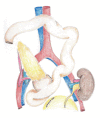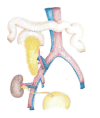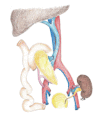Exocrine drainage in vascularized pancreas transplantation in the new millennium
- PMID: 27358771
- PMCID: PMC4919730
- DOI: 10.5500/wjt.v6.i2.255
Exocrine drainage in vascularized pancreas transplantation in the new millennium
Abstract
The history of vascularized pancreas transplantation largely parallels developments in immunosuppression and technical refinements in transplant surgery. From the late-1980s to 1995, most pancreas transplants were whole organ pancreatic grafts with insulin delivery to the iliac vein and diversion of the pancreatic ductal secretions to the urinary bladder (systemic-bladder technique). The advent of bladder drainage revolutionized the safety and improved the success of pancreas transplantation. However, starting in 1995, a seismic change occurred from bladder to bowel exocrine drainage coincident with improvements in immunosuppression, preservation techniques, diagnostic monitoring, general medical care, and the success and frequency of enteric conversion. In the new millennium, pancreas transplants are performed predominantly as pancreatico-duodenal grafts with enteric diversion of the pancreatic ductal secretions coupled with iliac vein provision of insulin (systemic-enteric technique) although the systemic-bladder technique endures as a preferred alternative in selected cases. In the early 1990s, a novel technique of venous drainage into the superior mesenteric vein combined with bowel exocrine diversion (portal-enteric technique) was designed and subsequently refined over the next ≥ 20 years to re-create the natural physiology of the pancreas with first-pass hepatic processing of insulin. Enteric drainage usually refers to jejunal or ileal diversion of the exocrine secretions either with a primary enteric anastomosis or with an additional Roux limb. The portal-enteric technique has spawned a number of newer and revisited techniques of enteric exocrine drainage including duodenal or gastric diversion. Reports in the literature suggest no differences in pancreas transplant outcomes irrespective of type of either venous or exocrine diversion. The purpose of this review is to examine the literature on exocrine drainage in the new millennium (the purported "enteric drainage" era) with special attention to technical variations and nuances in vascularized pancreas transplantation that have been proposed and studied in this time period.
Keywords: Enteric conversion; Pancreas transplantation; Portal-enteric drainage; Simultaneous pancreas-kidney transplant; Solitary pancreas transplant; Systemic-bladder drainage; Systemic-enteric drainage.
Figures




Similar articles
-
Pancreas transplantation with portal venous drainage with an emphasis on technical aspects.Clin Transplant. 2014 Jan;28(1):16-26. doi: 10.1111/ctr.12275. Epub 2013 Nov 8. Clin Transplant. 2014. PMID: 24410731 Review.
-
Comparison of pancreas transplantation with portal venous and enteric exocrine drainage to the standard technique utilizing bladder drainage of exocrine secretions.Transplantation. 1996 Nov 15;62(9):1353-6. doi: 10.1097/00007890-199611150-00030. Transplantation. 1996. PMID: 8932284
-
Exocrine drainage in pancreas transplantation: Complications and management.World J Transplant. 2020 Dec 28;10(12):392-403. doi: 10.5500/wjt.v10.i12.392. World J Transplant. 2020. PMID: 33437672 Free PMC article. Review.
-
Conversion of exocrine secretions from bladder to enteric drainage in recipients of whole pancreaticoduodenal transplants.Ann Surg. 1992 Dec;216(6):663-72. doi: 10.1097/00000658-199212000-00008. Ann Surg. 1992. PMID: 1466620 Free PMC article.
-
A prospective comparison of systemic-bladder versus portal-enteric drainage in vascularized pancreas transplantation.Surgery. 2000 Feb;127(2):217-26. doi: 10.1067/msy.2000.103160. Surgery. 2000. PMID: 10686988
Cited by
-
Dueling with the dual artery blood supply in pancreas transplantation: why replace the Y?Gland Surg. 2024 Jul 30;13(7):1159-1163. doi: 10.21037/gs-24-121. Epub 2024 Jul 17. Gland Surg. 2024. PMID: 39175703 Free PMC article. No abstract available.
-
Enteric Conversion of Bladder-drained Pancreas as a Predictor of Outcomes in Almost 600 Recipients at a Single Center.Transplant Direct. 2020 Apr 22;6(5):e550. doi: 10.1097/TXD.0000000000000997. eCollection 2020 May. Transplant Direct. 2020. PMID: 32548244 Free PMC article.
-
Back-table surgery pancreas allograft for transplantation: Implications in complications.World J Transplant. 2021 Jan 18;11(1):1-6. doi: 10.5500/wjt.v11.i1.1. World J Transplant. 2021. PMID: 33552938 Free PMC article. Review.
-
Retroperitoneal pancreas transplantation with a Roux-en-Y duodenojejunostomy for exocrine drainage.BMC Surg. 2024 Nov 13;24(1):357. doi: 10.1186/s12893-024-02658-y. BMC Surg. 2024. PMID: 39538165 Free PMC article.
-
Heparin Thromboprophylaxis in Simultaneous Pancreas-Kidney Transplantation: A Systematic Review and Meta-Analysis of Observational Studies.Transpl Int. 2023 Feb 1;36:10442. doi: 10.3389/ti.2023.10442. eCollection 2023. Transpl Int. 2023. PMID: 36819126 Free PMC article.
References
-
- Gruessner RW, Gruessner AC. The current state of pancreas transplantation. Nat Rev Endocrinol. 2013;9:555–562. - PubMed
-
- Kandaswamy R, Skeans MA, Gustafson SK, Carrico RJ, Tyler KH, Israni AK, Snyder JJ, Kasiske BL. OPTN/SRTR 2013 Annual Data Report: pancreas. Am J Transplant. 2015;15 Suppl 2:1–20. - PubMed
-
- Stratta RJ, Rogers J, Farney AC, Orlando G, El-Hennawy H, Gautreaux MD, Reeves-Daniel A, Palanisamy A, Iskandar SS, Bodner JK. Pancreas transplantation in C-peptide positive patients: does “type” of diabetes really matter? J Am Coll Surg. 2015;220:716–727. - PubMed
Publication types
LinkOut - more resources
Full Text Sources
Other Literature Sources

